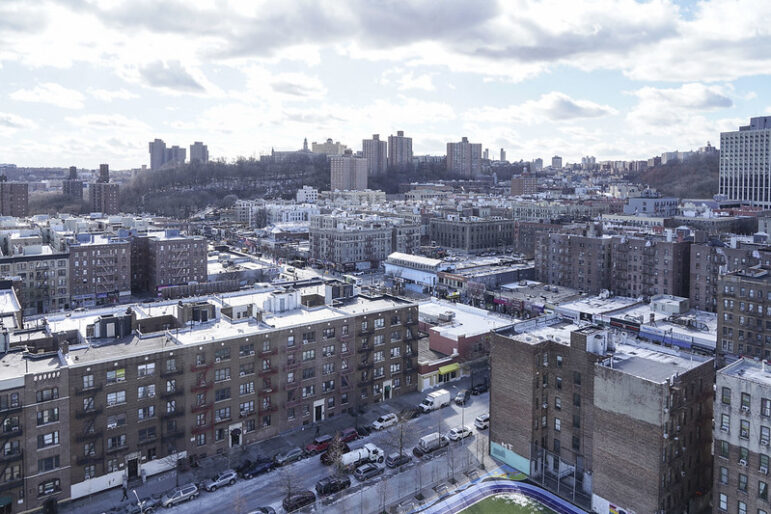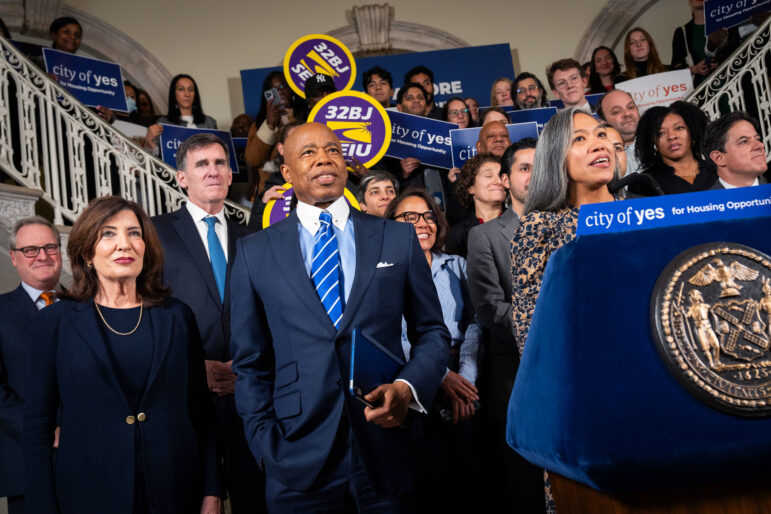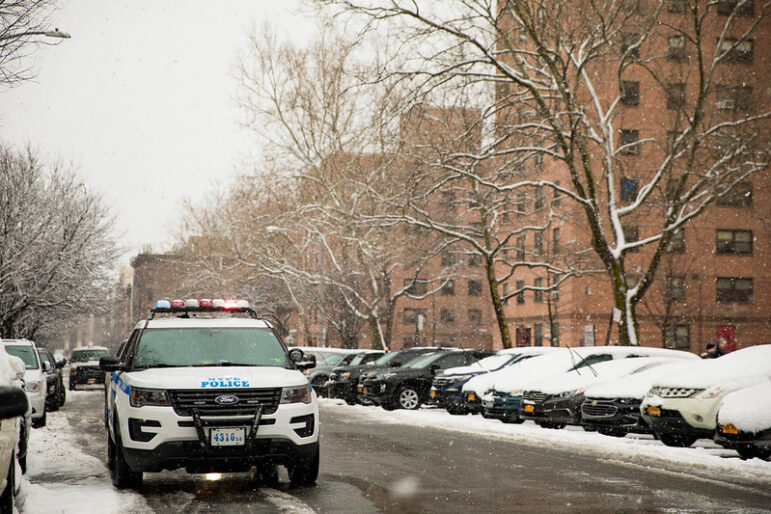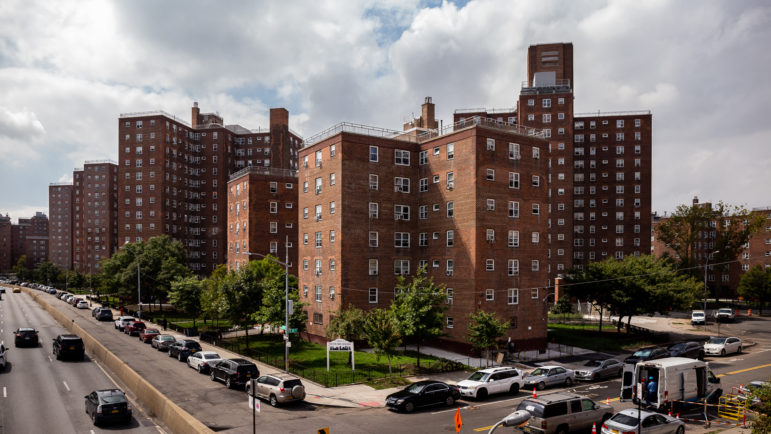While the city will keep funding a network of immigrant-serving community-based organizations and nonprofit legal service providers, they will no longer be required to provide institutional programming with a physical staff presence in places like hospitals, schools, and libraries, as ActionNYC does.

NYC Mayor’s Office
Former Mayor Bill de Blasio announcing the Launch of ActionNYC, a program to provide information and free legal help to immigrant New Yorkers, in late 2015.Lea la versión en español aquí.
ActionNYC, a program launched under the Bill de Blasio administration as the “nation’s largest investment by a municipality” to provide information and legal support to immigrant New Yorkers, is set to end this year after nearly a decade.
The Mayor’s Office of Immigrant Affairs (MOIA), overseeing the program since its inception in 2015, will replace it with two initiatives: MOIA Immigration Legal Support Centers and MOIA’s Legal Technical Mentorship.
However, while the new program incorporates some elements of ActionNYC, its replacement is significantly different, according to sources familiar with the matter and Councilmember Alexa Aviles, chair of the Immigration Committee.
While the city will keep funding a network of immigrant-serving community-based organizations and nonprofit legal service providers, they will no longer be required to provide institutional programming with a physical staff presence in places like hospitals, schools, and libraries, as ActionNYC does.
A MOIA spokesperson declined to discuss the changes, citing the ongoing Request for Proposals (RFP) for the new programs. “This is an active procurement so we are unable to discuss the procurement in detail,” the spokesperson said.
Though MOIA is the responsive agency for the program and the RFP, the city’s Department of Social Services/Human Resources Administration is supporting the office in the procurement process.
“DSS/HRA and MOIA publicly published multiple ‘Addenda’ to the RFx which incorporates responses to questions and changes responsive to feedback,” the spokesperson added. “The goal of our office as always is to ensure the access and continuity of legal services and resources, to the greatest extent possible.”
The RFP notes that the selected providers will work out of “designated locations for the MOIA Immigration Legal Support Centers.”
Previously under the ActionNYC program, legal services providers served people directly in public spaces. In hospitals, for example, providers assisted people who often needed to change or adjust their immigration status to access healthcare and treatment.
“The expansion of services into hospitals has proved another effective way to reach particularly vulnerable populations,” reads a MOIA report from 2018, a year after the city launched the program in the NYC Health + Hospitals system.
Similarly, the ActionNYC in Schools program, launched in 2016, provided legal services to youth and their families in city schools, identifying dozens of young people who qualified for Special Immigrant Juvenile Status visas, asylum, or other benefits.
And since 2021, ActionNYC has been providing a one-stop shop for English as a Second Language (ESL) classes, citizenship preparation courses, and assistance with filing legal documentation at Brooklyn Public Library, New York Public Library, and Queens Public Library branches.
According to the new RFP for MOIA’s planned Immigration Legal Support Centers, providers “with a variety of legal and non-legal navigation and support services” will instead “maintain close outreach and referral partnerships with local schools, hospitals, libraries, and houses of worship.”
Sources familiar with the matter who spoke to City Limits on condition of anonymity said providers were told to stop accepting cases for the program in schools, libraries, and hospitals, and to wind down services by the end of the year.
When asked, MOIA didn’t directly address this point, but a spokesperson for the office said that it “recently announced a new structure that will allow community-based organizations to directly access resources, rather than relying solely on large legal providers not located in immigrant communities.”
“While the program will undergo rebranding and a change in contractors,” the MOIA spokesperson said in a statement, “we will continue our million-dollar investments to provide core legal services for immigrants and help them achieve the American Dream.”
But Councilmember Avilés cited concerns about the transition.
“ActionNYC has been a lifeline for countless immigrant New Yorkers looking to become citizens, maintain legal status, or reunite with loved ones,” Avilés said in a statement to City Limits. “Providers have warned that this new proposed model cause gaps and reductions in service which could be devastating for our communities and providers.”
When asked about the reason for the program’s redesign, MOIA said it’s to reflect the city’s current needs, and the renaming is so it’s clear and easily translatable.
MOIA said it’s using lessons learned from ActionNYC to move toward a system that delivers services directly to communities and builds the capacity of community-based organizations.
In its latest annual report, MOIA described ActionNYC as “MOIA’s anchor initiative” implemented in collaboration with over 30 community-based organizations and legal services providers.
The incoming MOIA Immigration Legal Support Centers will rely on up to 25 such groups, plus an organization awarded to run MOIA’s new Legal Technical Mentorship, which will provide legal and non-legal support services to local organizations to improve access and outreach within immigrant communities.
An income eligibility cap was also added to the program, at 200 percent of the federal poverty guidelines (equivalent to $62,400 a year for a family of four) “ensuring that the program serves immigrant New Yorkers most in need,” according to MOIA’s most recent annual report.
While ActionNYC has seen high demand since its inception—in multiple annual reports, MOIA has acknowledged that the program has been at or near capacity—the new RFP may incentivize providers to take on only straightforward cases and overlook others, according to sources familiar with the matter.
Under the contract, each of the 25 providers must complete a minimum required total of 600 “Units of Service,” explains the RFP, making the first time organizations need to count representation as service units.
A comprehensive immigration legal screening plus full representation in a straightforward case, for example, counts as one unit, while the same procedure plus full representation in a complex case counts as six units.
Those more complicated cases can take months or even years to complete, requiring more preparation. Attorneys and applicants might need to gather evidence before filing and require multiple meetings. Straightforward cases, by contrast, can be filed in a matter of hours if applicants have all the information required.

MOIA’s 2018 Annual Report
ActionNYC cases in 2017, broken down by how complex the cases were by location.MOIA does not publish specific information on the percentage of simple versus complicated cases that providers take on under ActionNYC. But the results included in MOIA’s 2018 annual report—the only year that offered such a detailed breakdown—show big differences in case complexity depending where they were opened by providers. Schools saw the highest percentage of complicated cases that year, at 36 percent.
MOIA said the city reserves the right to make necessary changes to ensure programs continue to meet New Yorkers’ needs, and that public feedback following the release of a concept paper in 2023 was instrumental in informing the changes to the model.
MOIA has also changed the name of the ActionNYC hotline, a city-funded immigration legal support phone service, to the MOIA Immigration Legal Support Hotline. The hotline received
62,497 calls in 2023, according to MOIA’s annual report—a record-high, and a a 457 percent increase since the service was launched in 2015.
The redesign of the program comes after the arrival of more than 217,300 migrants and asylum seekers to New York over the last two years, nearly 63,000 of whom were in the city’s shelter system at the end of August, according to data tracked by City Limits.
To reach the reporter behind this story, contact Daniel@citylimits.org. To reach the editor, contact Jeanmarie@citylimits.org
Want to republish this story? Find City Limits’ reprint policy here.








